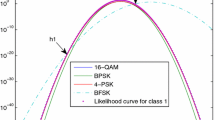Abstract
Digital modulation identification is a challenging and important operation in the security communication field. Identifying properly a digital modulation and its parameters is a key operation in many applications, such as cognitive radio, communication intelligence and dynamic spectrum allocation. However, traditional methods face a stalemate in which the accuracy of the identification process is quite low. Therefore, new descriptors are needed as an alternative solution or to complement the existing ones. Using a new method from the field of nonlinear dynamic systems, namely the phase diagram representation, we want to extract some features to help recognizing the type of used modulations. This method can be used even in noisy backgrounds, with the help of an additional processing algorithm, to give important information about the signal and the used modulation.



















Similar content being viewed by others
Data availability statement
The data set generated and analysed during the current study is available from the corresponding author on reasonable request.
References
D.H. Al-Nuaimi, I.A. Hashim, I.S. Zainal Abidin, L.B. Salman, N.A. Mat Isa, Performance of feature-based techniques for automatic digital modulation recognition and classification—a review. Electronics 8, 1407 (2019)
J.L. Xu, W. Su, M. Zhou, Likelihood-ratio approaches to automatic modulation classification. IEEE Trans. Syst. Man Cybern. C 41, 455–469 (2011)
A. Hazza, M. Shoaib, S.A. Alshebeili, A. Fahad, An overview of feature-based methods for digital modulation classification, in 2013 1st International Conference on Communications, Signal Processing, and Their Applications (ICCSPA). (IEEE, Sharjah, 2013), pp. 1–6
O.A. Dobre, A. Abdi, Y. Bar-Ness, W. Su, Survey of automatic modulation classification techniques: classical approaches and new trends. IET Commun. 1, 137 (2007)
M. Pedzisz, A. Mansour, Automatic modulation recognition of MPSK signals using constellation rotation and its 4th order cumulant. Digit. Signal Process. 15, 295–304 (2005)
K.N. Haq, A. Mansour, S. Nordholm, Classification of digital modulated signals based on time frequency representation, in 2010 4th International Conference on Signal Processing and Communication Systems. (IEEE, Gold Coast, Australia, 2010), pp. 1–5
A. Digulescu, C. Ioana, I. Candel, A. Serbanescu, On the recognitions capabilities of modulated signals in phase diagram domain, in 2018 International Conference on Communications (COMM). (IEEE, Bucharest, 2018), pp. 177–180
A. Digulescu, I. Murgan, C. Ioana, I. Candel, A. Serbanescu, Applications of transient signal analysis using the concept of recurrence plot analysis, in Recurrence Plots and Their Quantifications: Expanding Horizons. ed. by C.L. Webber, C. Ioana, N. Marwan (Springer International Publishing, Cham, 2016), pp.19–38
M.J. de-Ridder-de-Groote, R. Prasad, J.H. Bons, Analysis of new methods for broadcasting digital data to mobile terminals over an FM-channel. IEEE Trans. Broadcast 40, 29–37 (1994)
J. Song, Y. Wang, Y. Liu, Iterative interpolation for parameter estimation of LFM signal based on fractional Fourier transform. Circuits Syst. Signal Process. 32, 1489–1499 (2013)
S. Lo, B. Peterson, P. Enge, P. Swaszek, Loran data modulation: extensions and examples. IEEE Trans. Aerosp. Electron. Syst. 43, 628–644 (2007)
J.P. Zbilut, C.L. Webber, Embeddings and delays as derived from quantification of recurrence plots. Phys. Lett. A 171, 199–203 (1992)
H. Sabelli, A. Sugerman, L. Kovacevic, L. Kauffman, L. Carlson-Sabelli, M. Patel, J. Konecki, Bios data analyzer. Nonlinear Dyn. Psychol. Life Sci. 9, 505–538 (2005)
J.-P. Eckmann, S.O. Kamphorst, D. Ruelle, Recurrence plots of dynamical systems. Europhys. Lett. 4, 973–977 (1987)
H. Kantz, T. Schreiber, Nonlinear Time Series Analysis (Cambridge Univ. Press, Cambridge, 2010)
N. Marwan, M. Carmenromano, M. Thiel, J. Kurths, Recurrence plots for the analysis of complex systems. Phys. Rep. 438, 237–329 (2007)
C. Ioana, A. Digulescu, A. Serbanescu, I. Candel, F.-M. Birleanu, Recent advances in non-stationary signal processing based on the concept of recurrence plot analysis, in Translational Recurrences. ed. by N. Marwan, M. Riley, A. Giuliani, C.L. Webber (Springer International Publishing, Cham, 2014), pp.75–93
R. Scripcaru, D. Nastasiu, A. Digulescu, D. Stanescu, C. Ioana, A. Serbanescu, On the potential of phase diagram analysis to identify the wide band modulations, in 2020 13th International Conference on Communications (COMM). (IEEE, Bucharest, Romania, 2020), pp. 55–58
D. Kopitz, B. Marks, RDS, the Radio Data System (Artech House, Boston, 1999)
S. Lo, B. Peterson, P. Enge, P. Swaszek, Loran data modulation: extensions and examples. IEEE Trans. Aerosp. Electron. Syst. 43, 628–644 (2007)
N. Saulig, Ž Milanović, C. Ioana, A local entropy-based algorithm for information content extraction from time-frequency distributions of noisy signals. Digit. Signal Process. 70, 155–165 (2017)
Acknowledgements
The authors are grateful to AID-DGA (l’Agence de l’Innovation de Défense à la Direction Générale de l’Armement – Ministère des Armées) & ANR (Agence Nationale de le Recherche en France) for supporting our ANR-ASTRID – Project (ANR-19-ASTR-0005-03).
Author information
Authors and Affiliations
Corresponding author
Rights and permissions
Springer Nature or its licensor (e.g. a society or other partner) holds exclusive rights to this article under a publishing agreement with the author(s) or other rightsholder(s); author self-archiving of the accepted manuscript version of this article is solely governed by the terms of such publishing agreement and applicable law.
About this article
Cite this article
Stanescu, D., Nastasiu, D., Ioana, C. et al. Characterization of digital modulations using the phase diagram analysis. Eur. Phys. J. Spec. Top. 232, 187–199 (2023). https://doi.org/10.1140/epjs/s11734-022-00744-x
Received:
Accepted:
Published:
Issue Date:
DOI: https://doi.org/10.1140/epjs/s11734-022-00744-x




